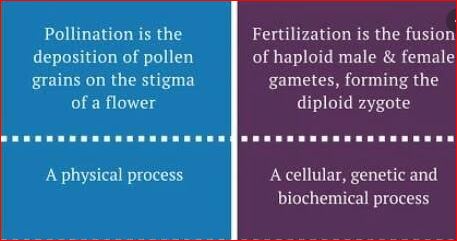What is Difference Between Pollination and Fertilization?
difference Between Pollination and Fertilization is that Pollination is the transport of pollen from plants from the stamens (male organs of the flowers that originate the pollen grains) to the receptive part of the flowers, where the ovules of the flower germinate and fertilize, making possible the production of seeds and fruits

The term fertilization has two uses in two different contexts, but both widely spread.
On the one hand, fertilization refers to the process through which it will be prepared to the earth by adding various substances that have the objective of making it more fertile and useful when sowing and planting seeds.
The formation of gametophytes
In the nuclear of the interior of the ovule, a diploid stem cell causes meiosis by four haploid megaspores, of which three degenerate and one experiences three mitotic divisions, which originates eight nuclei and seven cells. The set forms the female gametophyte.
In the stamens of pollen sacs, there are hundreds of thousands of pollen stem cells, each originating four grains of pollen per meiosis. Inside the pollen sac, the pollen grain is divided to form the male gametophyte.
The pollination
When the pollen has matured, the pollen tubes of the anthers open and the pollen grains, which are transported by wind, water or animals, are allowed to escape. Pollination is the passage of pollen grain from the anther to a stigma.
When it does so until the stigma of the same flower or another flower of the same plant, we talk about self – pollination.
When pollen is transported from the anther of a flower to the stigma of a flower of another plant of the same species, we talk about cross-pollination.
Pollination by wind orAnemogam is the simplest, but the most expensive, since large quantities of pollen must be produced so that at least some reach some stigma.
Pollination by insects or entomógama is more complicated but more effective. The plants adapt to the tastes of insects and their flowers attract them thanks to their colorful petals and the aroma of their nectar. Pollination by water is exceptional since pollen is usually rendered useless when wet.
– Double fertilization
When the pollen grain reaches the stigma, it germinates and forms the pollen tube.
The generative cell forms the male gametes. The pollen tube enters the egg through the micropile.
Release 2 male gametes: the nucleus of one will enter the ovocell and the nucleus of the other will join the 2 polar nuclei.
This is known as double fertilization and is characteristic of angiosperms. A diploid zygote and a triploid nucleus or endosperm nucleus emerge.
– The development of the seed
From the double fertilization three processes are initiated:
1.- The zygote develops and originates the embryo, which consists of three parts:
radicle, plumule or tallito and embryonic or cotyledon leaves.
2.- The triploid nucleus gives rise to albumen, which serves as a source of nutrients for the development of the embryo and even for the development of the seedling.
The embryo absorbs all or almost all of the reserve tissue in the cotyledons before entering dormancy.
3.- The covers of the seminal primordium originate the teguments of the seed.
These play an important role in maintaining latency status, characterized by less metabolic activity.
The embryo and albumen surrounded by the teguments form the seed. difference Between Pollination and Fertilization
– Fruit formation
After fertilization, the flowers undergo alterations: the sepals and the petals and other parts of the flower disappear. The transformation of the ovum into seed and that of the ovary into a fruit occur simultaneously.
The wall of the ovary becomes the pericarp, which differs into layers:
exocarp or outer layer, mesocarp or intermediate layer and the endocarp or inner layer.
A simple fruit develops from a carpel or several attached carpels. An added fruit is formed from several separate carpels. multiple fruits are built from a group of flowers.
The function of the fruit is to favor the dispersion of the seeds.
Seed dispersion allows plants to reproduce in new habitats. difference Between Pollination and Fertilization
You May Also Interested:
